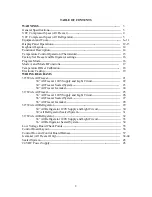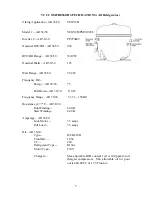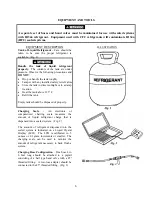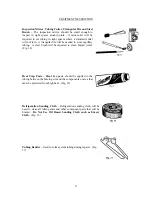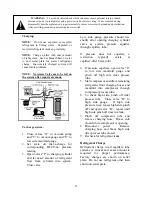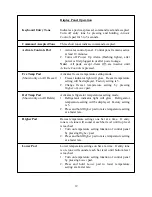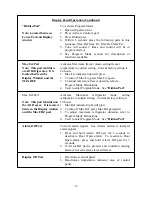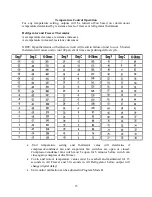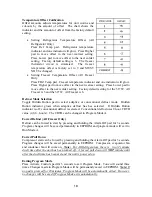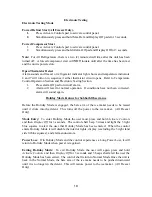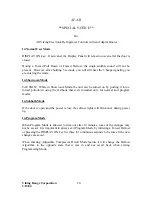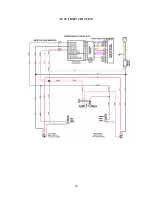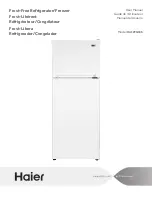
10
WARNING
To avoid electrical shock which can cause severe personal injury or death, disconnect
power to refrigerator using power switch before servicing. Wires removed during
disassembly must be replaced on proper terminals to insure correct earth ground and
polarization. After servicing, reconnect power using power switch.
Evacuation and Charging
CAUTION: To avoid risk of fire, sealed
refrigeration system must be air free. To
reduce risk of air contamination, follow
evacuation procedures exactly.
NOTE:
Before opening any refrigeration
system, EPA regulations require refrigerant in
system to be captured for safe disposal.
Proper evacuation of sealed refrigeration system
is an important service procedure. Usable life
and operational efficiency greatly depends upon
low completely air, moisture and other non-
condensables are evacuated from sealed system.
Air in sealed system causes high condensing
temperature and pressure, resulting in increased
power requirements and reduced performance.
Moisture in sealed system chemically reacts
with refrigerant and oil to form corrosive
hydrofluoric and hydrochloric acids. These
acids attack motor windings and parts, causing
premature breakdown.
Before opening system, evaporator coil must be
at ambient temperature to minimize moisture
infiltration into system.
Evacuation:
To evacuate sealed refrigeration
system:
1.
Connect vacuum pump, vacuum tight
manifold set with high vacuum hoses,
thermocouple vacuum gauge and
charging cylinder as shown in
illustration. Evacuation should be done
through I.D. opening of tubes not
through line piercing valve.
2.
Connect low side line to compressor
process tube.
3.
Connect high side line to drier/process
tube.
4.
Evacuate both simultaneously. With
valve “C” and “F” closed, open all other
valves and start vacuum pump.
Equipment Setup For Evacuation and Charging
5.
After compound gauge (low side) drops
to approximately 29 inches gauge, open
valve “C” to vacuum thermocouple
gauge and take micron reading.
NOTE:
A high vacuum pump can only produce
a good vacuum if oil in pump is not
contaminated.
6.
Continue evacuating system until
vacuum gauge registers 200 microns.
7.
At 200 microns, close valve “A” to
vacuum pump and allow micron reading
in system to balance. Micron lever will
rise.
•
If in 2 minutes, micron level stabilizes at
400 microns or below, system is ready
to be charges.
•
If micron level rises above 400 microns
and stabilizes, open valve “A” and
continue evacuating.
•
If micron reading rises rapidly and does
not stabilize, a leak still exists in system.
Close valve “A” to vacuum pump an
valve “C” to vacuum gauge. Invert
charging cylinder and open charging
cylinder valve “F” to add partial charge
for leak checking. With leak detector,
check manifold connections and system
for leaks. after locating leak, capture
refrigerant, repair leak, and begin at step 1.
Summary of Contents for Designer DDFB304
Page 1: ...F90612...
Page 2: ...F90612 VIKING RANGE CORPORATION P O DRAWER 956 GREENWOOD MS 38930 USA...
Page 22: ...21 Wiring Schematic 30 W All Freezer...
Page 23: ...22 AF 30 LIGHT CIRCUITS...
Page 24: ...23 AF 30 120V CIRCUIT...
Page 25: ...24 AF 30 SEALED SYSTEM...
Page 26: ...25 AF 30 ICEMAKER CIRCUIT...
Page 27: ...26 Wiring Schematic 36 W All Freezer...
Page 28: ...27 AF 36 LIGHT CIRCUITS...
Page 29: ...28 AF 36 120V CIRCUIT...
Page 30: ...29 AF 36 SEALED SYSTEM...
Page 31: ...30 AF 36 ICEMAKER CIRCUIT...
Page 32: ...31 Wiring Schematic 30 W All Refrigerator...
Page 33: ...32 AR 30 120V INPUT AR 30 LIGHT CIRCUITS...
Page 34: ...33 AR 30 SEALED SYSTEM...
Page 35: ...34 Wiring Schematic 36 W All Refrigerator...
Page 36: ...35 AR 36 120V INPUT AR 36 LIGHT CIRCUITS...
Page 37: ...36 AR 36 SEALED SYSTEM...
Page 39: ...38 ALL MODELS New Control Boards with adapter functionality...
Page 40: ...39...
Page 48: ...47 SEALED SYSTEM...



